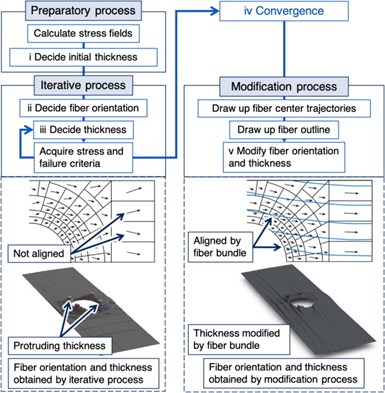Optimization approach helps design lighter carbon fiber composites
Approach developed by Tokyo University of Science for manufacturing carbon fibers with optimized orientation and thickness achieves more than a 5% weight reduction in fiber-reinforced materials.

Photo Credit: Stefan Fluck
Researchers from Tokyo University of Science (TUS, Japan) have adopted a new design method that optimizes both carbon fiber thickness and orientation, achieving weight reduction in fiber-reinforced composites and opening doors to lighter aircrafts and automotive vehicles.
TUS points to carbon fiber-reinforced polymers (CFRP) which has been continuously studied to improve strength. Most of these studies, says TUS, have focused on a particular technique called “fiber-steered design,” which optimizes fiber orientation to enhance strength.
However, the fiber-steered design approach is not without its drawbacks. “Fiber-steered design only optimizes orientation and keeps the thickness of the fibers fixed, preventing full use of the mechanical properties of CFRP. A weight reduction approach, which allows optimization of fiber thickness as well, has been rarely considered,” explains Dr. Ryosuke Matsuzaki from TUS, whose research is focused on composite materials.
Against this backdrop, Dr. Matsuzaki — along with his colleagues at TUS, Yuto Mori and Naoya Kumekawa — proposed a new design method for optimizing the fiber orientation and thickness simultaneously depending on the location in the composite structure, which allowed them to reduce the weight of the CFRP compared to that of a constant thickness linear lamination model without compromising its strength. Their findings can be read in a new study published in Composite Structures.
General scheme of simultaneous design of fiber orientation and thickness. Photo Credit: Tokyo University of Science (TUS).
Their method consisted of three steps: the preparatory, iterative and modification processes. In the preparatory process, an initial analysis was performed using the finite element method (FEM) to determine the number of layers, enabling a qualitative weight evaluation by a linear lamination model and a fiber-steered design with a thickness variation model. The iterative process was used to determine the fiber orientation by the principal stress direction and iteratively calculate the thickness using “maximum stress theory.” Finally, the modification process was used to make modifications accounting for manufacturability by first creating a reference “base fiber bundle” in a region requiring strength improvement and then determining the final orientation and thickness by arranging the fiber bundles such that they spread on both sides of the reference bundle.
The method of simultaneous optimization led to a weight reduction greater than 5% while enabling higher load transfer efficiency than that achieved with fiber orientation alone.
The researchers note that they’re excited by these results and look forward to the future implementation of their method for further weight reduction of conventional CFRP parts. “Our design method goes beyond the conventional wisdom of composite design, making for lighter aircraft and automobiles, which can contribute to energy conservation and reduction of CO2 emissions,” observes Dr. Matsuzaki.
Related Content
-
Automotive chassis components lighten up with composites
Composite and hybrid components reduce mass, increase functionality on electric and conventional passenger vehicles.
-
“Structured air” TPS safeguards composite structures
Powered by an 85% air/15% pure polyimide aerogel, Blueshift’s novel material system protects structures during transient thermal events from -200°C to beyond 2400°C for rockets, battery boxes and more.
-
Carbon fiber, bionic design achieve peak performance in race-ready production vehicle
Porsche worked with Action Composites to design and manufacture an innovative carbon fiber safety cage option to lightweight one of its series race vehicles, built in a one-shot compression molding process.

















